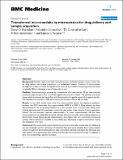Transdermal microconduits by microscission for drug delivery and sample acquisition
Author(s)
Gonzalez, Salvador; Herndon, Terry O.; Gowrishankar, Thiruvallur R.; Anderson, R. Rox; Weaver, James C.
Download1741-7015-2-12.pdf (882.7Kb)
PUBLISHER_CC
Publisher with Creative Commons License
Creative Commons Attribution
Terms of use
Metadata
Show full item recordAbstract
Background Painless, rapid, controlled, minimally invasive molecular transport across human skin for drug delivery and analyte acquisition is of widespread interest. Creation of microconduits through the stratum corneum and epidermis is achieved by stochastic scissioning events localized to typically 250 μm diameter areas of human skin in vivo. Methods Microscissioning is achieved by a limited flux of accelerated gas: 25 μm inert particles passing through the aperture in a mask held against the stratum corneum. The particles scize (cut) tissue, which is removed by the gas flow with the sensation of a gentle stream of air against the skin. The resulting microconduit is fully open and may be between 50 and 200 μm deep. Results In vivo adult human tests show that microconduits reduce the electrical impedance between two ECG electrodes from approximately 4,000 Ω to 500 Ω. Drug delivery has been demonstrated in vivo by applying lidocaine to a microconduit from a cotton swab. Sharp point probing demonstrated full anaesthesia around the site within three minutes. Topical application without the microconduit required approximately 1.5 hours. Approximately 180 μm deep microconduits in vivo yielded blood sample volumes of several μl, with a faint pricking sensation as blood enters tissue. Blood glucose measurements were taken with two commercial monitoring systems. Microconduits are invisible to the unaided eye, developing a slight erythematous macule that disappears over days. Conclusion Microscissioned microconduits may provide a minimally invasive basis for delivery of any size molecule, and for extraction of interstitial fluid and blood samples. Such microconduits reduce through-skin electrical impedance, have controllable diameter and depth, are fully open and, after healing, no foreign bodies were visible using through-skin confocal microscopy. In subjects to date, microscissioning is painless and rapid.
Date issued
2004-04Department
Harvard University--MIT Division of Health Sciences and TechnologyJournal
BMC Medicine
Publisher
BioMed Central Ltd
Citation
Herndon, Terry et al. “Transdermal microconduits by microscission for drug delivery and sample acquisition.” BMC Medicine 2.1 (2004): 12.
Version: Final published version
ISSN
1741-7015